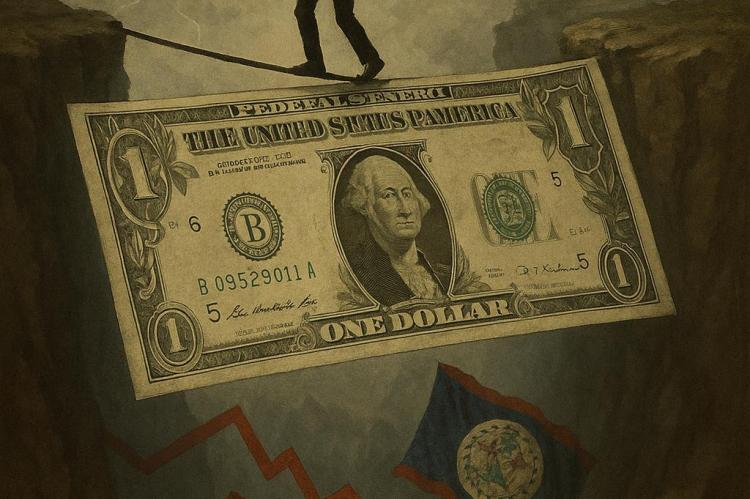🇧🇿💲 Belize’s 2:1 Peg to the U.S. Dollar: What It Means
By Omar Silva – Editor Publisher
National Perspective Belize – Digital 2025
Belize City: Tuesday 22nd April 2025
For over four decades, Belize has maintained a seemingly stable economic tether: the Belize dollar (BZD) pegged at a fixed rate of BZD $2 to USD $1. This arrangement, officially introduced in 1978, has been praised for offering predictability in trade, attracting tourism, and preserving price stability in an economy heavily reliant on imports.
But as global markets reel from volatility and the U.S. economy teeters on the edge of stagflation or worse, this peg—long seen as a pillar of stability—is revealing its darker underbelly.
A Fragile Foundation in Turbulent Times
The U.S. Federal Reserve is battling a complex storm: high inflation, high interest rates, rising debt ceilings, and an overstretched dollar. Stock market dips over the last few days signal investor unease, while some economists whisper warnings of a looming recession—or worse, a long stagnation.
For Belize, this is more than a headline from abroad. It’s a direct economic threat.
The 2:1 peg means that Belize cannot independently adjust its monetary policy. To maintain this fixed rate, the Central Bank must hold enough U.S. dollars in reserve to back every Belize dollar in circulation. If U.S. interest rates rise or global trade slows, Belize faces a triple threat: fewer tourist dollars, higher import prices, and more expensive debt repayments.
Imported Inflation, Exported Instability
Belize imports over 80% of its essential goods—fuel, food, medication, machinery—all typically priced in U.S. dollars. As the USD becomes more volatile or weakened, Belizean consumers bear the brunt through higher prices and eroded purchasing power.
Meanwhile, the debt trap tightens. With most of Belize’s external debt denominated in U.S. dollars, and interest rates now far above historic norms, the cost of servicing those debts climbs sharply. The result? Less fiscal space for social spending, and more dependence on grants and foreign aid.
U.S. Crisis, Belizean Collapse?
Should the United States slip into a prolonged economic downturn, the consequences for Belize would be immediate and devastating:
- Tourism revenue would decline, reducing one of Belize’s top foreign exchange earners.
- Remittances from the diaspora would shrink, weakening household income and consumption.
- USAID, MCC, and other funding streams could dry up or be redirected, leaving development projects stranded midstream.
- Most dangerously, a run on Belize’s U.S. dollar reserves could trigger a devaluation crisis, shaking public confidence in the Belize dollar and the government’s ability to manage the economy.
Locked in a Colonial Cage
This crisis is not just economic. It is deeply political.
For decades, Belize’s colonial-era political structure has served an extractive class—a tight circle of elites and career politicians who leverage public office to benefit private interests. Both major parties have shown little will to diversify the economy, invest in domestic production, or restructure the country’s outdated financial framework.
Belizeans are now paying the price for decades of political inertia.
Instead of building resilience through manufacturing, agriculture, or regional integration, Belize remains overly dependent on the U.S. dollar, on U.S. grants, and on U.S.-centric financial institutions. The 2:1 peg has preserved the illusion of stability, but it has come at the cost of sovereignty, flexibility, and economic independence.
The Way Forward: Decouple or diversify?
Belize must now confront a difficult but necessary question: Is the 2:1 peg still serving our national interest?
There are several options:
- Diversify foreign reserves by holding a mix of USD, Mexican pesos, Guatemalan quetzales, euros, and gold.
- Forge regional trade deals that allow settlement in local currencies or barter-based exchanges.
- Strengthen domestic production to reduce dependence on imported goods priced in USD.
- Audit and potentially repatriate key national assets, particularly in energy, fuel distribution, and ports, to secure national control.
Above all, Belize must adopt a new economic philosophy grounded in sovereignty, sustainability, and self-reliance. The time for dependency politics has passed.
As the U.S. grapples with its own reckoning, Belize has a choice: cling to a crumbling peg and sink deeper into crisis or take bold steps to redefine its financial future. The clock is ticking.
- Log in to post comments

